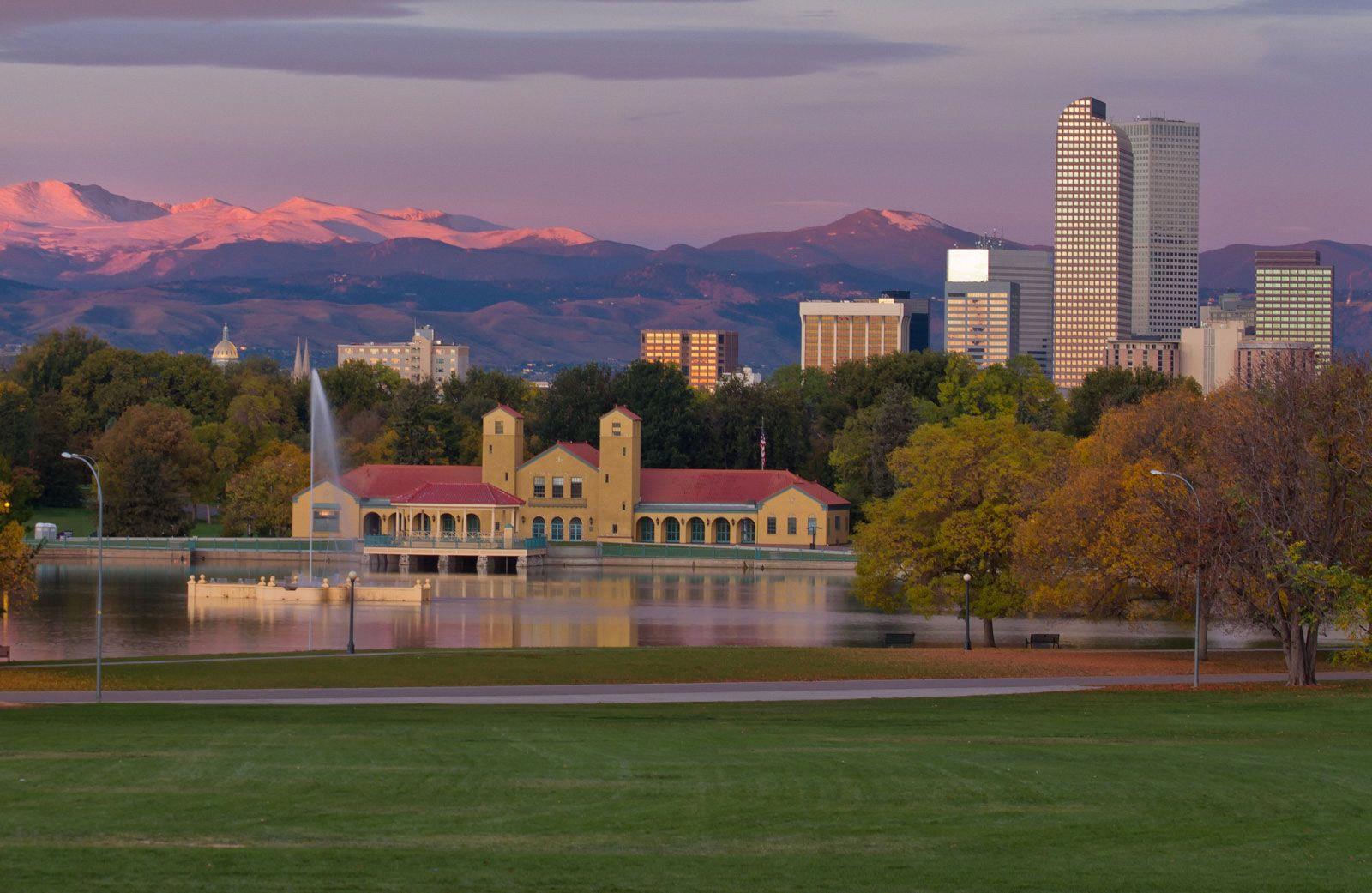Denver, Colorado is a city known for its beautiful mountain views and outdoor adventures. However, it’s important to note that Denver is not just any ordinary city – it sits at a high elevation above sea level. In fact, Denver is known as the “Mile High City” becase it sits exactly one mile above sea level, at an elevation of 5,280 feet (1,609 meters)!
The elevation of Denver has a significant impact on the city’s climate and weather patterns. Due to the high elevation, the air is thinner and drier than at lower elevations. This can make it more difficult to breathe and can also cause dehydration more quickly. It’s important for visitors to Denver to drink plenty of water and take it easy during their first few days in the city to avoid altitude sickness.
Altitude sickness is a common issue for those traveling to high elevations, and Denver is no exception. Symptoms of altitude sickness can include headaches, nausea, dizziness, and fatigue. It’s important to allow your body time to adjust to the higher elevation before engaging in any strenuous activities.
Despite the challenges of high altitude, Denver’s elevation also has many benefits. The thin air and low humidity make for great skiing conditions in the nearby Rocky Mountains. Additionally, the higher elevation means that Denver gets more sunlight and less pollution than many other cities.
So, if you’re planning a trip to Denver, be prepared for the high elevation and take steps to acclimate to the altitude. And don’t forget to enjoy the stunning mountain views and outdoor adventures that this unique city has to offer!
What is the Highest Elevation Town in the US?
The town with the highest elevation in the United States is Leadville, which sits at an impressive altitude of 10,152 feet (3,094 meters) above sea level. Located in Colorado, Leadville is not only the highest elevated city in the US, but it also boasts the title of the second highest community in the state. The town is nestled in the Rocky Mountains and is known for its rich mining history, stunning natural scenery, and outdoor recreational opportunities, including hiking, skiing, and mountain biking. Despite its high elevation, Leadville is a thriving community with a population of around 2,500 residents, and it attracts visitors from around the world who come to experience its unique blend of history, culture, and natural beauty.

Source: 9news.com
The Prevalence of Altitude Sickness in Denver
Altitude sickness, also known as acute mountain sickness (AMS), is a common condition that affects some individuals when they travel to high altitude locations such as Denver, Colorado. Approximately one in five people experience symptoms of altitude sickness when traveling to the mountains of Colorado. Denver is known as the “Mile High City” because its elevation is precisely one mile (5,280 feet) above sea level. While some individuals may not experience any symptoms at this altitude, others may feel the effects of the thinner air and lower oxygen levels. Symptoms of altitude sickness can include headache, fatigue, dizziness, nausea, and difficulty sleeping. It is important to note that altitude sickness can be a serious condition, and travelers to high altitudes should take precautions such as drinking plenty of water, avoiding alcohol and smoking, and gradually acclimating to the altitude over sevral days. If symptoms persist or become severe, medical attention should be sought immediately.
Adjusting to Denver Altitude: How Long Does It Take?
When traveling to Denver, a person’s body will need time to adjust to the higher altitude. It usually takes about 24 to 36 hours for the body to acclimate to the change in altitude. During this time, the body will be adjusting to the decrease in oxygen and the decrease in air pressure. It’s important to take it easy during this period and avoid any strenuous activity that could exacerbate any symptoms of altitude sickness. If someone is experiencing persistent headaches, loss of appetite, vomiting, and continued lack of sleep by the secod night, it’s essential to seek medical attention. acclimating to the altitude in Denver is a gradual process and requires patience and self-care.
The Elevation of Denver: Exploring the Reasons Behind Its High Altitude
Denver is located on the High Plains, which are situated at an elevation of approximately 5,280 feet (1,609 meters) above sea level. Geologists attribute the city’s high elevation to water. According to the prevailing theory, chemical reactions that were triggered by water deep below the Earth’s surface caused the North American plate to rise several million years ago. As a result, the High Plains were pushed above sea level, and Denver ended up being situated at a high elevation. Additionally, the city’s proximity to the Rocky Mountains contributes to its elevated position. The mountains, which are located to the west of Denver, rise to an elevation of over 14,000 feet (4,267 meters), and their presence creates a natural barrier that prevents lower elevation air masses from moving into the area. This results in a drier climate and clearer skies, which are amog the factors that make Denver an attractive place to live and visit.
The Effects of Living at High Altitude on the Body
Living at high altitude, where the air is thinner and contains less oxygen, can have significant effects on the body. As the body adjusts to the lower oxygen levels, it responds by increasing the production of red blood cells, which are responsible for carrying oxygen from the lungs to the rest of the body. This process, known as acclimatization, can take seveal weeks and is critical for survival at high altitude.
However, even with acclimatization, the body may still experience a range of effects. The most common symptoms of altitude sickness include headaches, nausea, fatigue, dizziness, and difficulty sleeping. In severe cases, altitude sickness can lead to more serious conditions such as pulmonary edema (fluid in the lungs) or cerebral edema (swelling in the brain), which can be life-threatening.
Living at high altitude can also affect physical performance. Due to the lower oxygen levels, the body has to work harder to generate energy, which can result in reduced endurance, strength, and speed. This can be especially challenging for athletes who train at high altitude, as they must balance the benefits of increased red blood cell production with the negative effects on performance.
Living at high altitude can have significant effects on the body, including increased red blood cell production, altitude sickness, and reduced physical performance. It is important to acclimatize gradually and seek medical attention if symptoms of altitude sickness occur.

Source: britannica.com
Acclimating to High Altitude: How Long Does It Take?
Acclimatization to high altitude can take anywhere from a few days to a few weeks, depending on the individual and the altitude. The process of acclimatization involves the body making physiological changes to cope with the decreased oxygen levels at high altitude. These changes include an increase in breathing rate, an increase in heart rate, and an increase in the number of red blood cells.
The initial phase of acclimatization typically takes 3-5 days, during which time the body begins to adjust to the lower oxygen levels. It is recommended to acclimatize for a few days at an elevation of 8,000-9,000 ft (2,500-2,750 m) before proceeding to a higher elevation. This alows the body to adjust to the lower oxygen levels at a moderate elevation before moving on to a higher elevation.
However, full acclimatization can take up to several weeks, depending on the altitude. At very high altitudes, such as above 18,000 ft (5,500 m), the acclimatization process can be more difficult and may require a longer period of time. It’s important to note that not everyone will acclimatize at the same rate, and some individuals may never fully acclimatize to high altitude.
Adapting to Altitude: The Fastest Way
Unfortunately, there is no fast way to adjust to altitude. It takes time for your body to acclimate to the lower oxygen levels at higher elevations. The best way to adjust is to ascend gradually, avoiding traveling from a low elevation to an elevation higher than 9,000 feet (2,750 m) above sea level in one day. If possible, spend a few days at 8,000–9,000 feet before traveling to a higher elevation. This gies your body time to adjust to the lower oxygen levels. Additionally, staying hydrated and avoiding alcohol and smoking can help with acclimation. If you experience severe symptoms of altitude sickness, such as persistent headache, nausea, or shortness of breath, it is important to seek medical attention immediately.
Breathing Easier in Colorado
If you’re struggling to breathe in Colorado due to the high altitude, there are sevral things you can do to improve your breathing. First and foremost, it’s important to stay hydrated. Drinking plenty of water will help keep your respiratory system working effectively. Additionally, you should avoid alcohol and caffeine, as they can both dehydrate you and make it harder to breathe.
Getting rest and taking it easy physically can also help you breathe better. It can be tempting to try and push through the altitude sickness, but doing so can actually make your symptoms worse. Instead, take breaks and allow your body time to acclimate to the altitude.
If you’re still struggling to breathe, you might consider using supplemental oxygen. This can be obtained through a doctor, and can help relieve symptoms of altitude sickness. if your symptoms persist or become severe, seek medical attention. A doctor can evaluate your condition and provide additional treatments to help you breathe better in Colorado.
The Causes of Excessive Fatigue in Denver
The reason why you may feel tired in Denver could be due to the high altitude. At an elevation of 5,280 feet above sea level, Denver is known as the Mile-High City. At higher altitudes, the air pressure decreases, which in turn means that thre is less oxygen in the air. This can lead to a condition called altitude sickness, which can cause fatigue, headaches, shortness of breath, and difficulty sleeping. It can take several days for your body to acclimate to the change in altitude, during which time you may feel more tired than usual. Additionally, if you are engaging in physical activity, such as hiking or skiing, the combination of altitude and exertion can also contribute to feelings of exhaustion. It is important to stay hydrated and take it easy during the first few days at a high altitude to allow your body to adjust.

The Benefits of Living at a Healthy Altitude
According to a recent study conducted by researchers at the University of Colorado, living at altitudes around 5,000 feet or higher may have health benefits and increase lifespan. The study, which spanned four years, found that individuals living at higher altitudes had lower rates of cardiovascular disease and overall mortality rates. This is thought to be due to the increased exposure to low oxygen levels, which may stimulate the body to produce more red blood cells, leading to better circulation and overall health. However, it’s important to note that this study is just one piece of evidence and more research is needed to confirm these findings. Additionally, there are other factors to consider when deciding whee to live, such as access to healthcare, climate, and lifestyle preferences.
Treating Altitude Sickness
Altitude sickness is caused by exposure to low levels of oxygen at high altitudes, typically above 8,000 feet or 2,400 meters. The best way to prevent altitude sickness is to gradually acclimate to higher elevations by ascending slowly and allowing your body time to adjust. However, if you do experience altitude sickness, there are several things you can do to alleviate the symptoms.
Firstly, it is important to stop and rest where you are. Do not go any higher for at least 24 to 48 hours to alow your body to adjust. If you have a headache, taking ibuprofen or paracetamol can help to relieve the pain. If you feel nauseous or sick, taking an anti-sickness medicine, such as promethazine, can help to alleviate the symptoms.
It is also important to stay hydrated by drinking plenty of water. Dehydration can exacerbate the symptoms of altitude sickness and make you feel worse. However, it is important to avoid drinking alcohol or smoking, as these can both worsen the symptoms of altitude sickness.
Additionally, it is important to avoid strenuous exercise until you have acclimated to the altitude. It is also important to listen to your body and pay attention to any warning signs of altitude sickness, such as dizziness, fatigue, or shortness of breath. If your symptoms worsen or do not improve, it is important to seek medical attention.
Treating Altitude Sickness in Colorado
Altitude sickness can be a common issue for visitors to Colorado due to the state’s high elevation. However, there are a few things you can do to help prevent or alleviate altitude sickness symptoms. Firstly, it is recommended to stay below 7,000 feet on the first day to allow your body time to adjust. This is particularly important if you are coming from a lower altitude. It is also a good idea to avoid strenuous exercise on the first day and limit alcohol intake. Drinking more water than usual can also help, as high altitudes can cause dehydration. Additionally, alays travel with a companion in case you do experience altitude sickness symptoms. If you do feel unwell, there are over-the-counter remedies available at pharmacies or you may wish to consult with a medical professional. By following these tips, you can help prevent or alleviate altitude sickness symptoms and enjoy your time in Colorado.
The Health Benefits of Living at High Altitude
The answer to the question of whether it is healthier to live at high altitude is not straightforward as it largely depends on the individual’s health condition and the altitude they are considering. High altitude may have protective effects on cardiovascular diseases due to the lower oxygen levels that stimulate the body to produce more red blood cells, which in turn improves blood flow and oxygen delivery to the body tissues. However, living at high altitude may also have harmful effects on chronic pulmonary disease (COPD) as the thinner air can make breathing difficult and worsen respiratory symptoms.
Moreover, high altitude may have beneficial effects on mortality from some types of cancer due to the reduced exposure to UV radiation and the increased production of melatonin, a hormone that has been linked to a lower risk of cancer. However, living at high altitude may also increase the risk of other health problems such as altitude sickness, dehydration, and frostbite.
Therefore, before deciding to move to a high altitude location, it is crucial to consult a healthcare professional to assess the individual’s health condition and discuss any potential risks and benefits. Additionally, it is essential to take appropriate precautions such as staying hydrated, avoiding alcohol and smoking, and gradually acclimatizing to the altitude to minimize the risks assciated with high altitude living.

Source: zacalife.com
The Difficulty of Breathing in Denver Compared to Chicago
It is harder to breathe in Denver than Chicago due to the difference in altitude. Denver is situated at an elevation of approximately 5,280 feet above sea level, whle Chicago is only 594 feet above sea level. Since the air pressure decreases with increasing altitude, the air in Denver is less dense, which means that there are fewer oxygen molecules per unit volume of air. Although the percentages of the components of air, including oxygen, are the same in both cities, the overall density of the air in Denver is lower. Therefore, to get the same amount of oxygen to our muscles in Denver as we do in Chicago, we must breathe extra deeply or extra quickly. This can result in shortness of breath, fatigue, and other symptoms for people who are not acclimated to the high altitude. It is important to note that some individuals may experience more severe symptoms than others, and those with pre-existing health conditions may be at a greater risk of complications when traveling to high altitudes.
Adjusting to Altitude in Denver
Adjusting to altitude in Denver can be challenging for some people, but not for everyone. The city is located exactly one mile above sea level, which means the air is thinner and contains less oxygen. This can case shortness of breath, headaches, and fatigue, especially for people who are not used to living at high altitudes. However, most healthy individuals can adjust to the altitude within a few days to a week. To make the adjustment easier, it is recommended to drink plenty of water, avoid alcohol and caffeine, and take it easy for the first few days. Additionally, it is important to be aware of the symptoms of altitude sickness, which can be more severe and require medical attention. adjusting to the altitude in Denver may be a challenge for some, but with proper care and awareness, it can be a smooth transition.
Conclusion
The elevation of Denver plays a significant role in the city’s geography, climate, and even its nickname. At 5,280 feet (1,609 meters) above sea level, Denver is considered a high-altitude city, and as such, visitors may experience symptoms of altitude sickness. However, with proper acclimation, most people can adjust to the altitude. Geologists believe that water played a crucial role in the formation of Denver’s unique topography, and a new theory suggests that chemical reactions triggered by water deep beow the Earth’s surface could have caused the North American plate to rise, pushing the High Plains above sea level. the elevation of Denver is a fascinating aspect of the city that contributes to its natural beauty and unique characteristics.
